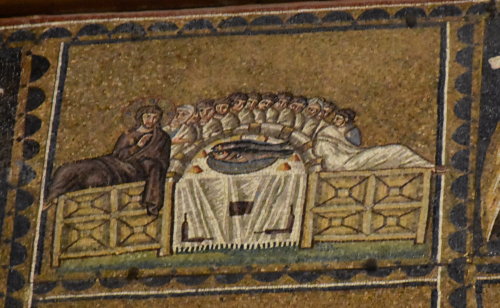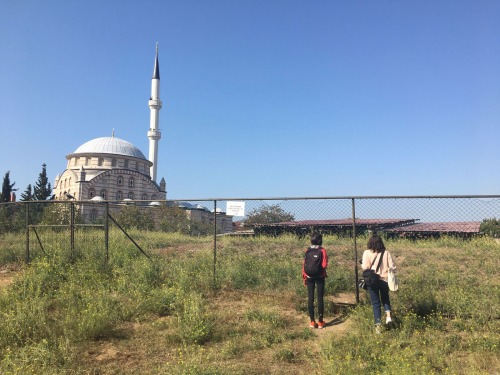
My family has a reliable routine when it comes to our Christmas celebration. Food often takes center stage: waffles for breakfast and—except for a misguided and disastrous dalliance with a turducken—for dinner we always have the same menu of goose, stuffing, and rice pudding. There are plentiful gingerbread men and a gorgeous stollen bread from our talented neighbor. In preparation for the feast, every Christmas Eve we have a lighter charcuterie-based dinner and watch Scrooge (A Christmas Carol) (the 1951 version directed by Brian Desmond Hurst starring Alastair Sim).
In the film and in Dickens’ parable, Ebenezer Scrooge recovers his generous spirit through the visits of three ghosts: Christmas past, present, and future. Given the particularly dire state of Scrooge’s miserly soul, it is striking that his deceased colleague Jacob Marley waited for seven years to enlist the phantoms’ aid on the anniversary of his death, Christmas Eve. It is as if the holiday is a weak point in the flow of time where spirits might enter, and happy memories might become tangible once again. Scrooge relives his own past, pleasant and otherwise, and learns how to “keep Christmas.” And as a song (“Barbara Allen”) featured in the film worms its way into my ear for its annual winter residence, I am reminded that holidays are circular periods where the same tastes and sights and sounds recur, bringing the present in harmony with the past.
As the season of winter festivities approaches, I want to offer a taste of how the Byzantines (specifically the imperial household) celebrated holidays. As a kid I bemoaned the innovation of the turducken, and as an adult, I keep this egregious breach of protocol in living memory by recalling it at least once during Christmas dinner. I am, thus, very sympathetic towards Constantine VII Porphyrogennetos, who in the mid-tenth century assembled a collection of directions for court ceremonial in the hope that they would always be carried out properly. The Book of Ceremonies details many different ceremonies, from court appointments to funerals. It also records what should be done for church feasts and holidays. For example, the Byzantine emperors celebrated the Twelve Days of Christmas (the period that runs from Christmas day to Epiphany) with twelve full days of feasting. The Kletorologion, an earlier text included in Constantine’s collection, directs who should come to dinner and where they should sit, or more accurately, where they should recline.[1]Liudprand of Cremona, an ambassador to Constantine VII’s court, records that during the Christmas feasts, guests in the Hall of Nineteen Couches reclined for their meal. He describes the use of golden platters so heavy that they had to be lifted onto the table with a pulley system.[2] Harun Ibn Yahya, a Syrian hostage living in the court in the late ninth or earlytenth century, also mentions golden platters so large they had to be wheeled in.[3]

Figure 2. For a sense of the luxurious table settings used in the palace, we might look at the collection of liturgical chalices from the Attarouthi Treasure (silver and gilt silver, 500–650, The Metropolitan Museum of Art).
The feasts also included entertainment. Harun recounts the playing of the organ, which was used in many imperial acclamations.[1]Liudprand details acrobats climbing up and moving around a pole balanced on a man’s forehead.[2] The Book of Ceremonies directs that on the ninth day of Christmas, the “Gothic Game” should be played after the jugglers depart. The game consisted of members of the chariot racing factions, the Blues and Greens, dressed as “Goths” (in furs turned inside out so that hair faced outward). The “Goths” ran in circles shouting “Toultoul!”and in turn the declaimers of the factionsrecited an acrostic in honor of the emperor. The words used by both the “Goths” and the poets included a mix of Latin and Germanic words that gave the game its name.[3] Though the instructions for the Gothic Game are impenetrable to me, the yearly dance between Latin and Germanic syllables reinscribes Constantinople’s connection to Rome.

Figure 3. This image of the Last Supper from Sant’ApollinareNuovo (sixth century, Ravenna) gives us an idea of the Roman form of dining while reclined. The Byzantines continued this tradition on certain festive occasions like Christmas.
The great feasts of the major holidays may have included raucous acclamations, acrobats, and an impressive spread of delicacies, but the Byzantine elites also marked days with simpler commemorations. On the Thursday before Easter, for instance, the emperor visited the homes for the aged and then, after the liturgy, he gave high-level courtiers two apples and a stick of cinnamon.[1] During my research on court ceremonial, I have often been struck by this offering, which appears simple in contrast to more typical distribution of imperial largess through gold or sumptuous fabrics. Cinnamon was a highly valued spice, but such a small amount, along with two apples, resists an easy transformation into the showy displays of status enabled by gold and silks. The gift seems meant for private, personal consumption, and therefore, it appears more intimate. Though I do not know what the courtiers did with their gifts, apple and cinnamon also evokes a combination of flavors with which we are familiar today. It is a taste and scent that I associate with warm social occasions throughout the colder months.
The Book of Ceremonies also records more idiosyncratic celebrations. It notes that for the Triumph of Orthodoxy (celebrating the end of Iconoclasm), the patriarch Theophylact would add incense to the celebration. He also had sweetmeats at the chapel of St. Theophylact with the ruler and his invited guests.[1] Among the often-impersonal directions, this record stands out as a moment of personalized commemoration—one that the patriarch shared with others through sweet treats. A similar tradition is kept at ANAMED, where fellows often leave small delicacies near the coffee and tea station after research trips or in celebration of the holidays of our many countries.
Beyond my admiration for his employment of good smells and tastes, Theophylact’s efforts to enrich the commemoration of a historical moment speak to me. As an art historian, I often visit the objects or places that I study. Sometimes I do so with friends or colleagues, and we discuss what we are seeing. For instance, two intrepid fellows and I made a trip to the monastery and likely burial site of another patriarch, Ignatios, on his feast day (October 23).

Figure 4. Fellows visit the KüçükyalıArkeopark on October 23, the feast day of Patriarch Ignatios. Photo by Artemis Papatheodorou.
At the Satyros Monastery, now KüçükyalıArkeopark, we were amazed by the size of the complex as we walked around its border. We told stories about Ignatios, informally recounting his life. I left purple flowers. I cannot quite articulate why it seemed important to me to go on the day of Ignatios’ feast. Nothing magical happened. We were the only ones there. I think perhaps it stems from the desire to allow the past to guide our steps a bit, in this case through the choice of a date. The choice transformed the trip into something of a small pilgrimage that devoted a little time in the present to a long-dead saint. Even when not commemorating a specific day or person, looking closely at objects and spaces and the stories and histories we tell each other in their company would seem to bear an invitation for the ghost of the past to pay us a visit. After all, Jacob Marley first appeared through a door knocker.

Figure 5. Jacob Marley in Scrooge’s door knocker, Scrooge (A Christmas Carol) (Hurst, 1951).
[1]Ann Moffatt and Maxeme Tall, eds., The Book of Ceremonies: With the Greek edition of the Corpus Scriptorum Historiae Byzantinae (Bonn, 1829), vol. 2 (Canberra: Australian Association for Byzantine Studies, 2012; reprint, paperback by Leiden: Brill, 2017), Bk. 2, ch. 52, 741–759.
[2]Bishop of Cremona Liudprand, The Complete Works of Liudprand of Cremona, trans. Paolo Squatriti (Washington, D.C.: Catholic University of America Press, 2007), Bk. 6, ch. 8, pp. 199–200.
[3]Alexei Vasiliev, “Harun-Ibn-Yahya and His Description of Constantinople,” Seminarium Kondakovianum V(1932): 157; Andrew Dalby, Flavours of Byzantium (Totnes: Prospect, 2003), 116–119.
[4]Vasiliev, “Harun-Ibn-Yahya and His Description of Constantinople,” 157–158.
[5]Liudprand, Complete Works, Bk. 6, ch. 9, p. 200.
[6]Moffatt and Tall, Book of Ceremonies, vol. 1, Bk. 1, ch. 83, pp. 381–386.
[7]Book of Ceremonies, vol. 1, Bk. 1, ch. 33, pp. 177–178. [1]Book of Ceremonies, vol. 1, Bk. 1, ch. 28, pp. 160.

